Introduction
Materials and Methods
1. Data sources
2. Cancer classification
3. Statistical analyses
Results
1. Incidence
Table 1
| Site/Type | New cases | Deaths | Prevalent casesa) | ||||||
|---|---|---|---|---|---|---|---|---|---|
|
|
|
|
|||||||
| Both sexes | Men | Women | Both sexes | Men | Women | Both sexes | Men | Women | |
| All sites | 247,952 | 130,618 | 117,334 | 82,204 | 50,817 | 31,387 | 2,276,792 | 998,948 | 1,277,844 |
|
|
|||||||||
| Lip, oral cavity, and pharynx | 4,064 | 2,892 | 1,172 | 1,283 | 972 | 311 | 31,447 | 20,948 | 10,499 |
|
|
|||||||||
| Esophagus | 2,748 | 2,451 | 297 | 1,564 | 1,404 | 160 | 12,684 | 11,274 | 1,410 |
|
|
|||||||||
| Stomach | 26,662 | 17,869 | 8,793 | 7,510 | 4,807 | 2,703 | 330,217 | 217,881 | 112,336 |
|
|
|||||||||
| Colon and rectum | 27,877 | 16,485 | 11,392 | 8,869 | 5,029 | 3,840 | 292,586 | 173,285 | 119,301 |
|
|
|||||||||
| Liver | 15,152 | 11,150 | 4,002 | 10,565 | 7,812 | 2,753 | 77,958 | 58,239 | 19,719 |
|
|
|||||||||
| Gallbladderb) | 7,452 | 4,012 | 3,440 | 5,192 | 2,784 | 2,408 | 26,685 | 13,770 | 12,915 |
|
|
|||||||||
| Pancreas | 8,414 | 4,324 | 4,090 | 6,775 | 3,452 | 3,323 | 16,415 | 8,293 | 8,122 |
|
|
|||||||||
| Larynx | 1,203 | 1,141 | 62 | 321 | 310 | 11 | 12,251 | 11,524 | 727 |
|
|
|||||||||
| Lung | 28,949 | 19,657 | 9,292 | 18,673 | 13,824 | 4,849 | 111,208 | 66,240 | 44,968 |
|
|
|||||||||
| Breast | 24,923 | 117 | 24,806 | 2,745 | 20 | 2,725 | 279,965 | 1,012 | 278,953 |
|
|
|||||||||
| Cervix uteri | 2,998 | - | 2,998 | 810 | - | 810 | 60,467 | - | 60,467 |
|
|
|||||||||
| Corpus uteri | 3,492 | - | 3,492 | 378 | - | 378 | 33,785 | - | 33,785 |
|
|
|||||||||
| Ovary | 2,947 | - | 2,947 | 1,369 | - | 1,369 | 25,683 | - | 25,683 |
|
|
|||||||||
| Prostate | 16,815 | 16,815 | - | 2,194 | 2,194 | - | 120,423 | 120,423 | - |
|
|
|||||||||
| Testis | 361 | 361 | - | 14 | 14 | - | 4,385 | 4,385 | - |
|
|
|||||||||
| Kidney | 5,946 | 4,135 | 1,811 | 1,076 | 764 | 312 | 54,652 | 36,986 | 17,666 |
|
|
|||||||||
| Bladder | 4,753 | 3,826 | 927 | 1,593 | 1,235 | 358 | 41,835 | 34,085 | 7,750 |
|
|
|||||||||
| Brain and CNS | 1,970 | 1,056 | 914 | 1,437 | 784 | 653 | 13,411 | 6,888 | 6,523 |
|
|
|||||||||
| Thyroid | 29,180 | 7,458 | 21,722 | 365 | 128 | 237 | 489,688 | 91,546 | 398,142 |
|
|
|||||||||
| Hodgkin lymphoma | 323 | 214 | 109 | 48 | 30 | 18 | 3,657 | 2,255 | 1,402 |
|
|
|||||||||
| Non-Hodgkin lymphoma | 5,636 | 3,248 | 2,388 | 1,926 | 1,106 | 820 | 40,853 | 23,163 | 17,690 |
|
|
|||||||||
| Multiple myeloma | 1,747 | 961 | 786 | 976 | 514 | 462 | 8,307 | 4,381 | 3,926 |
|
|
|||||||||
| Leukemia | 3,605 | 2,020 | 1,585 | 1,825 | 1,048 | 777 | 27,157 | 15,045 | 12,112 |
|
|
|||||||||
| Other and ill-defined | 20,735 | 10,426 | 10,309 | 4,696 | 2,586 | 2,110 | 161,073 | 77,325 | 83,748 |
Table 2
| Site/Type | Crude incidence rate per 100,000 | Age-standardized incidence rate per 100,000a) | ||||
|---|---|---|---|---|---|---|
|
|
|
|||||
| Both sexes | Men | Women | Both sexes | Men | Women | |
| All sites | 482.9 | 510.1 | 455.8 | 262.2 | 279.1 | 257.3 |
|
|
||||||
| Lip, oral cavity, and pharynx | 7.9 | 11.3 | 4.6 | 4.4 | 6.4 | 2.6 |
|
|
||||||
| Esophagus | 5.4 | 9.6 | 1.2 | 2.6 | 4.9 | 0.5 |
|
|
||||||
| Stomach | 51.9 | 69.8 | 34.2 | 25.7 | 36.9 | 15.9 |
|
|
||||||
| Colon and rectum | 54.3 | 64.4 | 44.3 | 27.1 | 34.8 | 20.2 |
|
|
||||||
| Liver | 29.5 | 43.5 | 15.5 | 14.5 | 23.2 | 6.7 |
|
|
||||||
| Gallbladderb) | 14.5 | 15.7 | 13.4 | 6.2 | 7.7 | 4.9 |
|
|
||||||
| Pancreas | 16.4 | 16.9 | 15.9 | 7.6 | 8.7 | 6.7 |
|
|
||||||
| Larynx | 2.3 | 4.5 | 0.2 | 1.1 | 2.3 | 0.1 |
|
|
||||||
| Lung | 56.4 | 76.8 | 36.1 | 25.8 | 38.5 | 15.9 |
|
|
||||||
| Breast | 48.5 | 0.5 | 96.4 | 30.1 | 0.2 | 59.9 |
|
|
||||||
| Cervix uteri | 5.8 | - | 11.6 | 3.7 | - | 7.3 |
|
|
||||||
| Corpus uteri | 6.8 | - | 13.6 | 4.2 | - | 8.4 |
|
|
||||||
| Ovary | 5.7 | - | 11.4 | 3.5 | - | 7.0 |
|
|
||||||
| Prostate | 32.7 | 65.7 | - | 14.7 | 32.5 | - |
|
|
||||||
| Testis | 0.7 | 1.4 | - | 0.7 | 1.4 | - |
|
|
||||||
| Kidney | 11.6 | 16.1 | 7.0 | 6.6 | 9.4 | 3.9 |
|
|
||||||
| Bladder | 9.3 | 14.9 | 3.6 | 4.1 | 7.5 | 1.4 |
|
|
||||||
| Brain and CNS | 3.8 | 4.1 | 3.6 | 2.8 | 3.2 | 2.4 |
|
|
||||||
| Thyroid | 56.8 | 29.1 | 84.4 | 41.3 | 20.9 | 62.4 |
|
|
||||||
| Hodgkin lymphoma | 0.6 | 0.8 | 0.4 | 0.5 | 0.7 | 0.4 |
|
|
||||||
| Non-Hodgkin lymphoma | 11.0 | 12.7 | 9.3 | 6.6 | 8.1 | 5.2 |
|
|
||||||
| Multiple myeloma | 3.4 | 3.8 | 3.1 | 1.6 | 1.9 | 1.4 |
|
|
||||||
| Leukemia | 7.0 | 7.9 | 6.2 | 5.4 | 6.1 | 4.8 |
|
|
||||||
| Other and ill-defined | 40.4 | 40.7 | 40.0 | 21.4 | 23.7 | 19.4 |
2. Mortality
Table 3
| Rank | Cause of death | No. of deaths | Percentage of all deaths | Age-standardized death rate per 100,000a) |
|---|---|---|---|---|
| All causes | 304,948 | 100.0 | 249.4 | |
| 1 | Cancer | 82,204 | 27.0 | 69.9 |
| 2 | Heart disease | 32,347 | 10.6 | 24.2 |
| 3 | Cerebrovascular disease | 21,860 | 7.2 | 16.2 |
| 4 | Pneumonia | 22,257 | 7.3 | 14.8 |
| 5 | Intentional self-harm (suicide) | 13,195 | 4.3 | 17.9 |
| 6 | Diabetes mellitus | 8,456 | 2.8 | 6.3 |
| 7 | Disease of liver | 6,979 | 2.3 | 7.1 |
| 8 | Chronic lower respiratory diseases | 5,668 | 1.9 | 3.8 |
| 9 | Hypertensive diseases | 6,100 | 2.0 | 4.0 |
| 10 | Transport accidents | 3,947 | 1.3 | 4.6 |
| Others | 101,935 | 33.4 | 80.5 |
Source: Mortality Data, 2020, Statistics Korea [2].
Table 4
| Site/Type | Crude mortality rate per 100,000 | Age-standardized mortality rate per 100,000a) | ||||
|---|---|---|---|---|---|---|
|
|
|
|||||
| Both sexes | Men | Women | Both sexes | Men | Women | |
| All sites | 160.1 | 198.5 | 121.9 | 69.9 | 99.4 | 47.8 |
|
|
||||||
| Lip, oral cavity, and pharynx | 2.5 | 3.8 | 1.2 | 1.2 | 2.0 | 0.5 |
|
|
||||||
| Esophagus | 3.0 | 5.5 | 0.6 | 1.4 | 2.7 | 0.3 |
|
|
||||||
| Stomach | 14.6 | 18.8 | 10.5 | 6.4 | 9.5 | 4.1 |
|
|
||||||
| Colon and rectum | 17.3 | 19.6 | 14.9 | 7.2 | 9.9 | 5.2 |
|
|
||||||
| Liver | 20.6 | 30.5 | 10.7 | 9.4 | 15.7 | 3.9 |
|
|
||||||
| Gallbladderb) | 10.1 | 10.9 | 9.4 | 4.0 | 5.2 | 3.1 |
|
|
||||||
| Pancreas | 13.2 | 13.5 | 12.9 | 5.7 | 6.8 | 4.7 |
|
|
||||||
| Larynx | 0.6 | 1.2 | 0.0 | 0.3 | 0.6 | 0.0 |
|
|
||||||
| Lung | 36.4 | 54.0 | 18.8 | 14.9 | 25.9 | 6.6 |
|
|
||||||
| Breast | 5.3 | 0.1 | 10.6 | 2.9 | 0.0 | 5.6 |
|
|
||||||
| Cervix uteri | 1.6 | - | 3.1 | 0.8 | - | 1.5 |
|
|
||||||
| Corpus uteri | 0.7 | - | 1.5 | 0.4 | - | 0.7 |
|
|
||||||
| Ovary | 2.7 | - | 5.3 | 1.3 | - | 2.6 |
|
|
||||||
| Prostate | 4.3 | 8.6 | - | 1.5 | 4.0 | - |
|
|
||||||
| Testis | 0.0 | 0.1 | - | 0.0 | 0.0 | - |
|
|
||||||
| Kidney | 2.1 | 3.0 | 1.2 | 0.9 | 1.5 | 0.4 |
|
|
||||||
| Bladder | 3.1 | 4.8 | 1.4 | 1.2 | 2.3 | 0.4 |
|
|
||||||
| Brain and CNS | 2.8 | 3.1 | 2.5 | 1.6 | 1.9 | 1.3 |
|
|
||||||
| Thyroid | 0.7 | 0.5 | 0.9 | 0.3 | 0.2 | 0.3 |
|
|
||||||
| Hodgkin lymphoma | 0.1 | 0.1 | 0.1 | 0.0 | 0.1 | 0.0 |
|
|
||||||
| Non-Hodgkin lymphoma | 3.8 | 4.3 | 3.2 | 1.7 | 2.3 | 1.2 |
|
|
||||||
| Multiple myeloma | 1.9 | 2.0 | 1.8 | 0.8 | 1.0 | 0.6 |
|
|
||||||
| Leukemia | 3.6 | 4.1 | 3.0 | 1.9 | 2.4 | 1.5 |
|
|
||||||
| Other and ill-defined | 9.1 | 10.1 | 8.2 | 4.2 | 5.5 | 3.2 |
3. Trends in cancer incidence and mortality
Fig. 3
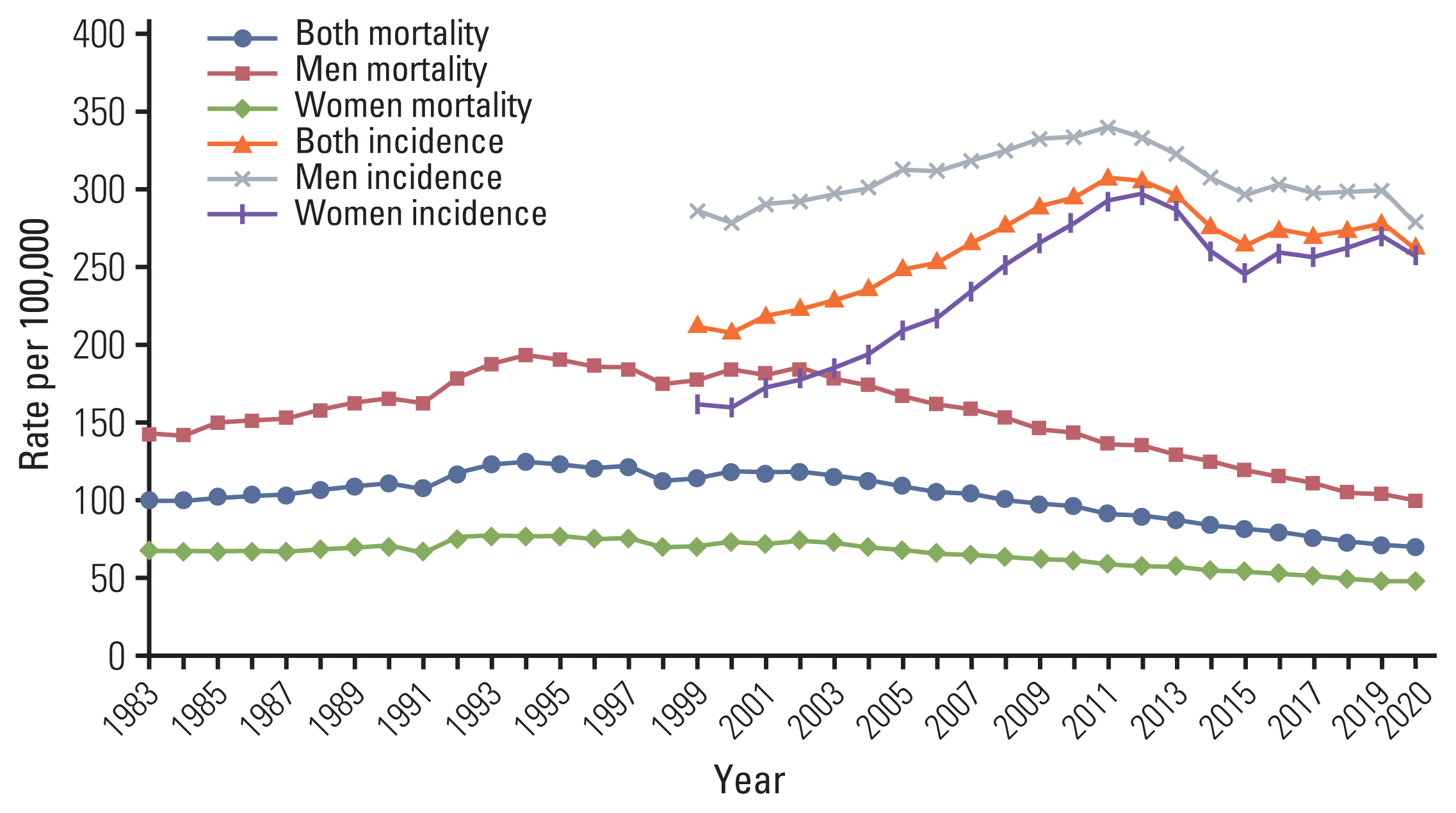
Table 5
| Site/Type | Incidence | Mortality | ||||||||||||||
|---|---|---|---|---|---|---|---|---|---|---|---|---|---|---|---|---|
|
|
|
|||||||||||||||
| 1999 | 2020 | Trend 1 | Trend 2 | Trend 3 | 1999 | 2020 | Trend 1 | Trend 2 | Trend 3 | |||||||
|
|
|
|
|
|
|
|||||||||||
| Years | APC | Years | APC | Years | APC | Years | APC | Years | APC | Years | APC | |||||
| All sites | 212.1 | 262.2 | 1999–2012 | 3.3a) | 2012–2015 | −5.0a) | 2015–2020 | 0.3 | 115.1 | 69.9 | 1999–2002 | 0.9 | 2002–2013 | −2.7a) | 2013–2020 | −3.3a) |
|
|
||||||||||||||||
| Lip, oral cavity, and pharynx | 3.6 | 4.4 | 1999–2020 | 0.7a) | - | - | - | - | 1.1 | 1.2 | 1999–2020 | −1.8a) | - | - | - | - |
|
|
||||||||||||||||
| Esophagus | 4.1 | 2.6 | 1999–2020 | −2.0a) | - | - | - | - | 3.1 | 1.4 | 1999–2020 | −4.3a) | - | - | - | - |
|
|
||||||||||||||||
| Stomach | 43.6 | 25.7 | 1999–2011 | −0.2 | 2011–2020 | −4.8a) | - | - | 23.9 | 6.4 | 1999–2002 | −2.5a) | 2002–2010 | −6.4a) | 2010–2020 | −7.2a) |
|
|
||||||||||||||||
| Colon and rectum | 20.5 | 27.1 | 1999–2006 | 7.3a) | 2006–2011 | 2.9a) | 2011–2020 | −3.8a) | 7.8 | 7.2 | 1999–2003 | 6.5a) | 2003–2012 | −0.5a) | 2012–2020 | −3.6a) |
|
|
||||||||||||||||
| Liver | 27.9 | 14.5 | 1999–2010 | −1.7a) | 2010–2020 | −4.3a) | - | - | 20.6 | 9.4 | 1999–2002 | 0.6 | 2002–2014 | −3.7a) | 2014–2020 | −5.9a) |
|
|
||||||||||||||||
| Gallbladderb) | 6.5 | 6.2 | 1999–2004 | 1.4 | 2004–2018 | −0.3 | 2018–2020 | −3.6 | 5.2 | 4.0 | 1999–2001 | 7.7 | 2001–2013 | −2.9a) | 2013–2020 | −0.7 |
|
|
||||||||||||||||
| Pancreas | 5.6 | 7.6 | 1999–2020 | 1.6a) | - | - | - | - | 5.5 | 5.7 | 1999–2020 | 0.1 | - | - | - | - |
|
|
||||||||||||||||
| Larynx | 2.4 | 1.1 | 1999–2020 | −3.5a) | - | - | - | - | 1.6 | 0.3 | 1999–2005 | −8.1a) | 2005–2008 | −15.5a) | 2008–2020 | −7.2a) |
|
|
||||||||||||||||
| Lung | 28.5 | 25.8 | 1999–2020 | −0.3a) | - | - | - | - | 22.5 | 14.9 | 1999–2001 | 3.6 | 2001–2013 | −1.9a) | 2013–2020 | −3.6a) |
|
|
||||||||||||||||
| Breast | 11.0 | 30.1 | 1999–2008 | 6.3a) | 2008–2020 | 4.1a) | - | - | 2.3 | 2.9 | 1999–2004 | 2.9a) | 2004–2020 | 0.8a) | - | - |
|
|
||||||||||||||||
| Cervix uteri | 8.6 | 3.7 | 1999–2007 | −4.6a) | 2007–2020 | −3.2a) | - | - | 1.4 | 0.8 | 1999–2003 | 10.1a) | 2003–2008 | −7.1a) | 2008–2020 | −4.2a) |
|
|
||||||||||||||||
| Corpus uteri | 1.4 | 4.2 | 1999–2020 | 5.1a) | - | - | - | - | 0.1 | 0.4 | 1999–2003 | 36.1a) | 2003–2020 | 2.3a) | - | - |
|
|
||||||||||||||||
| Ovary | 2.7 | 3.5 | 1999–2020 | 1.7a) | - | - | - | - | 0.9 | 1.3 | 1999–2020 | 0.6a) | - | - | - | |
|
|
||||||||||||||||
| Prostate | 3.1 | 14.7 | 1999–2009 | 14.8a) | 2009–2015 | 1 | 2015–2020 | 5.6a) | 0.9 | 1.5 | 1999–2002 | 15.0a) | 2002–2010 | 1.9a) | 2010–2020 | −1.1a) |
|
|
||||||||||||||||
| Testis | 0.3 | 0.7 | 1999–2020 | 4.8a) | - | - | - | - | 0.0 | 0.0 | 1999–2020 | −2.4a) | - | - | - | - |
|
|
||||||||||||||||
| Kidney | 3.0 | 6.6 | 1999–2009 | 6.4a) | 2009–2020 | 2.2a) | - | - | 1.1 | 0.9 | 1999–2016 | −0.2 | 2016–2020 | −4.7a) | - | - |
|
|
||||||||||||||||
| Bladder | 4.7 | 4.1 | 1999–2004 | 1.9 | 2004–2020 | −1.1a) | - | - | 1.3 | 1.2 | 1999–2002 | 9.3a) | 2002–2005 | −6.0 | 2005–2020 | −1.5a) |
|
|
||||||||||||||||
| Brain and CNS | 2.9 | 2.8 | 1999–2020 | 0.1 | - | - | - | - | 1.9 | 1.6 | 1999–2003 | 4.1a) | 2003–2008 | −4.3a) | 2008–2020 | −0.8a) |
|
|
||||||||||||||||
| Thyroid | 6.5 | 41.3 | 1999–2011 | 22.4a) | 2011–2016 | −12.1a) | 2016–2020 | 4.5 | 0.4 | 0.3 | 1999–2003 | 7.4a) | 2003–2020 | −4.5a) | - | - |
|
|
||||||||||||||||
| Hodgkin lymphoma | 0.3 | 0.5 | 1999–2011 | 4.9a) | 2011–2020 | 1.6 | - | - | 0.0 | 0.0 | 1999–2004 | 24.7a) | 2004–2020 | −2.6a) | - | - |
|
|
||||||||||||||||
| Non-Hodgkin lymphoma | 4.3 | 6.6 | 1999–2020 | 2.3a) | - | - | - | - | 2.1 | 1.7 | 1999–2020 | −1.1a) | - | - | - | - |
|
|
||||||||||||||||
| Multiple myeloma | 1.0 | 1.6 | 1999–2013 | 3.7a) | 2013–2020 | 0.3 | - | - | 0.6 | 0.8 | 1999–2003 | 12.8a) | 2003–2016 | 0.8 | 2016–2020 | −6.0a) |
|
|
||||||||||||||||
| Leukemia | 4.7 | 5.4 | 1999–2020 | 0.9a) | - | - | - | - | 2.9 | 1.9 | 1999–2020 | −1.9a) | - | - | - | - |
|
|
||||||||||||||||
| Other and ill-defined | 15.0 | 21.4 | 1999–2018 | 2.3a) | 2018–2020 | −2.1 | - | - | 7.8 | 4.2 | 1999–2020 | −2.7a) | - | - | - | - |
4. Survival rates
Table 6
| Site/Type | Both sexes | Men | Women | ||||||||||||||||||
|---|---|---|---|---|---|---|---|---|---|---|---|---|---|---|---|---|---|---|---|---|---|
|
|
|
|
|||||||||||||||||||
| 1993–1995 | 1996–2000 | 2001–2005 | 2006–2010 | 2011–2015 | 2016–2020 | Changea) | 1993–1995 | 1996–2000 | 2001–2005 | 2006–2010 | 2011–2015 | 2016–2020 | Changea) | 1993–1995 | 1996–2000 | 2001–2005 | 2006–2010 | 2011–2015 | 2016–2020 | Changea) | |
| All sites | 42.9 | 45.2 | 54.1 | 65.5 | 70.7 | 71.5 | 28.6 | 33.2 | 36.4 | 45.6 | 56.9 | 63.1 | 65.5 | 32.3 | 55.2 | 56.4 | 64.3 | 74.4 | 78.3 | 77.8 | 22.6 |
|
|
|||||||||||||||||||||
| All sites excluding thyroid | 41.2 | 43.4 | 50.9 | 59.1 | 64.3 | 67.3 | 26.1 | 32.7 | 35.9 | 44.7 | 54.6 | 60.4 | 63.4 | 30.7 | 52.6 | 53.5 | 59.1 | 65.0 | 69.4 | 72.2 | 19.6 |
|
|
|||||||||||||||||||||
| Lip, oral cavity, and pharynx | 42.2 | 47.4 | 54.5 | 61.1 | 65.5 | 69.4 | 27.2 | 36.6 | 41.7 | 49.7 | 56.9 | 61.8 | 66.7 | 30.1 | 59.4 | 64.5 | 68.1 | 72.1 | 74.5 | 75.8 | 16.5 |
|
|
|||||||||||||||||||||
| Esophagus | 14.0 | 15.7 | 21.6 | 30.0 | 36.6 | 42.2 | 28.2 | 13.0 | 14.7 | 20.8 | 29.4 | 36.2 | 41.8 | 28.7 | 25.0 | 25.9 | 29.8 | 37.3 | 39.6 | 45.6 | 20.6 |
|
|
|||||||||||||||||||||
| Stomach | 43.9 | 47.3 | 58.0 | 68.4 | 75.9 | 78.0 | 34.1 | 44.0 | 47.6 | 58.7 | 69.1 | 76.8 | 78.9 | 35.0 | 43.7 | 46.8 | 56.6 | 67.0 | 74.0 | 76.0 | 32.3 |
|
|
|||||||||||||||||||||
| Colon and rectum | 56.2 | 58.9 | 66.9 | 73.9 | 76.1 | 74.3 | 18.1 | 56.7 | 59.8 | 68.8 | 75.8 | 77.8 | 75.6 | 19.0 | 55.7 | 57.7 | 64.5 | 71.1 | 73.6 | 72.3 | 16.7 |
|
|
|||||||||||||||||||||
| Liver | 11.8 | 14.1 | 20.5 | 28.3 | 34.4 | 38.7 | 26.9 | 10.8 | 13.8 | 20.4 | 28.3 | 35.0 | 39.1 | 28.2 | 15.1 | 15.1 | 20.9 | 28.3 | 32.8 | 37.6 | 22.6 |
|
|
|||||||||||||||||||||
| Gallbladderb) | 18.7 | 20.7 | 23.1 | 26.9 | 28.8 | 29.0 | 10.4 | 18.0 | 21.1 | 23.5 | 27.8 | 29.5 | 29.8 | 11.7 | 19.3 | 20.3 | 22.7 | 26.0 | 28.0 | 28.2 | 8.9 |
|
|
|||||||||||||||||||||
| Pancreas | 10.6 | 8.7 | 8.4 | 8.6 | 10.9 | 15.2 | 4.6 | 10.0 | 8.3 | 8.4 | 8.3 | 10.3 | 14.2 | 4.2 | 11.5 | 9.3 | 8.4 | 8.9 | 11.6 | 16.2 | 4.7 |
|
|
|||||||||||||||||||||
| Larynx | 61.6 | 63.3 | 66.5 | 73.2 | 75.3 | 80.0 | 18.3 | 62.2 | 63.7 | 67.1 | 73.5 | 75.7 | 80.1 | 17.9 | 56.3 | 58.9 | 58.7 | 68.0 | 69.4 | 78.3 | 22.0 |
|
|
|||||||||||||||||||||
| Lung | 12.5 | 13.7 | 16.6 | 20.3 | 27.6 | 36.8 | 24.3 | 11.6 | 12.4 | 15.3 | 18.0 | 23.4 | 30.6 | 19.0 | 15.8 | 17.5 | 20.2 | 26.0 | 37.4 | 50.3 | 34.4 |
|
|
|||||||||||||||||||||
| Breast | 79.2 | 83.6 | 88.7 | 91.2 | 92.8 | 93.8 | 14.5 | 77.1 | 84.3 | 87.5 | 89.9 | 90.8 | 92.5 | 15.4 | 79.3 | 83.6 | 88.7 | 91.2 | 92.8 | 93.8 | 14.5 |
|
|
|||||||||||||||||||||
| Cervix uteri | 78.3 | 80.3 | 81.5 | 80.7 | 80.3 | 80.1 | 1.7 | - | - | - | - | - | - | - | 78.3 | 80.3 | 81.5 | 80.7 | 80.3 | 80.1 | 1.7 |
|
|
|||||||||||||||||||||
| Corpus uteri | 82.9 | 82.0 | 84.8 | 86.5 | 87.7 | 89.3 | 6.4 | - | - | - | - | - | - | - | 82.9 | 82.0 | 84.8 | 86.5 | 87.7 | 89.3 | 6.4 |
|
|
|||||||||||||||||||||
| Ovary | 60.1 | 59.4 | 61.7 | 61.3 | 64.9 | 64.7 | 4.6 | - | - | - | - | - | - | - | 60.1 | 59.4 | 61.7 | 61.3 | 64.9 | 64.7 | 4.6 |
|
|
|||||||||||||||||||||
| Prostate | 59.1 | 69.4 | 81.0 | 92.0 | 94.2 | 95.2 | 36.1 | 59.1 | 69.4 | 81.0 | 92.0 | 94.2 | 95.2 | 36.1 | - | - | - | - | - | - | - |
|
|
|||||||||||||||||||||
| Testis | 87.4 | 90.4 | 90.7 | 93.2 | 94.9 | 96.5 | 9.0 | 87.4 | 90.4 | 90.7 | 93.2 | 94.9 | 96.5 | 9.0 | - | - | - | - | - | - | - |
|
|
|||||||||||||||||||||
| Kidney | 64.2 | 67.0 | 73.7 | 78.6 | 82.6 | 85.7 | 21.4 | 63.4 | 65.3 | 73.0 | 78.5 | 82.2 | 85.8 | 22.4 | 65.8 | 70.3 | 74.9 | 78.9 | 83.4 | 85.3 | 19.4 |
|
|
|||||||||||||||||||||
| Bladder | 70.7 | 73.6 | 76.0 | 77.3 | 76.5 | 76.5 | 5.8 | 71.6 | 75.1 | 77.8 | 79.3 | 78.5 | 78.6 | 7.0 | 67.2 | 67.2 | 69.1 | 69.2 | 68.5 | 68.4 | 1.2 |
|
|
|||||||||||||||||||||
| Brain and CNS | 40.4 | 39.9 | 41.1 | 42.9 | 41.8 | 40.5 | 0.1 | 39.0 | 38.7 | 40.4 | 41.4 | 40.4 | 38.4 | −0.6 | 42.3 | 41.4 | 41.9 | 44.7 | 43.4 | 43.0 | 0.7 |
|
|
|||||||||||||||||||||
| Thyroid | 94.5 | 95.0 | 98.4 | 100.0 | 100.2 | 100.0 | 5.5 | 87.9 | 89.7 | 96.0 | 100.2 | 100.6 | 100.3 | 12.4 | 95.7 | 96.0 | 98.7 | 99.9 | 100.1 | 100.0 | 4.3 |
|
|
|||||||||||||||||||||
| Hodgkin lymphoma | 70.2 | 71.9 | 76.7 | 81.1 | 82.3 | 87.1 | 16.9 | 69.4 | 69.3 | 74.7 | 80.8 | 81.8 | 87.1 | 17.6 | 71.5 | 77.3 | 80.7 | 81.6 | 83.3 | 87.2 | 15.7 |
|
|
|||||||||||||||||||||
| Non-Hodgkin lymphoma | 48.3 | 51.1 | 56.0 | 59.4 | 62.9 | 65.4 | 17.1 | 46.8 | 49.6 | 55.0 | 59.2 | 62.9 | 65.9 | 19.1 | 50.7 | 53.3 | 57.5 | 59.7 | 62.8 | 64.8 | 14.1 |
|
|
|||||||||||||||||||||
| Multiple myeloma | 23.7 | 21.0 | 29.7 | 35.0 | 41.6 | 50.7 | 27.0 | 23.2 | 19.1 | 29.9 | 35.2 | 41.2 | 51.4 | 28.2 | 24.1 | 23.2 | 29.5 | 34.7 | 42.1 | 49.8 | 25.7 |
|
|
|||||||||||||||||||||
| Leukemia | 27.5 | 34.3 | 42.0 | 47.7 | 52.0 | 55.2 | 27.6 | 27.3 | 33.3 | 41.8 | 46.9 | 52.2 | 54.8 | 27.5 | 27.9 | 35.5 | 42.1 | 48.7 | 51.7 | 55.6 | 27.7 |
|
|
|||||||||||||||||||||
| Other and ill-defined | 44.5 | 48.4 | 57.9 | 67.7 | 72.8 | 76.4 | 31.9 | 39.6 | 44.7 | 54.1 | 63.8 | 69.4 | 73.4 | 33.8 | 50.1 | 52.7 | 62.0 | 71.6 | 76.2 | 79.3 | 29.2 |
Fig. 6
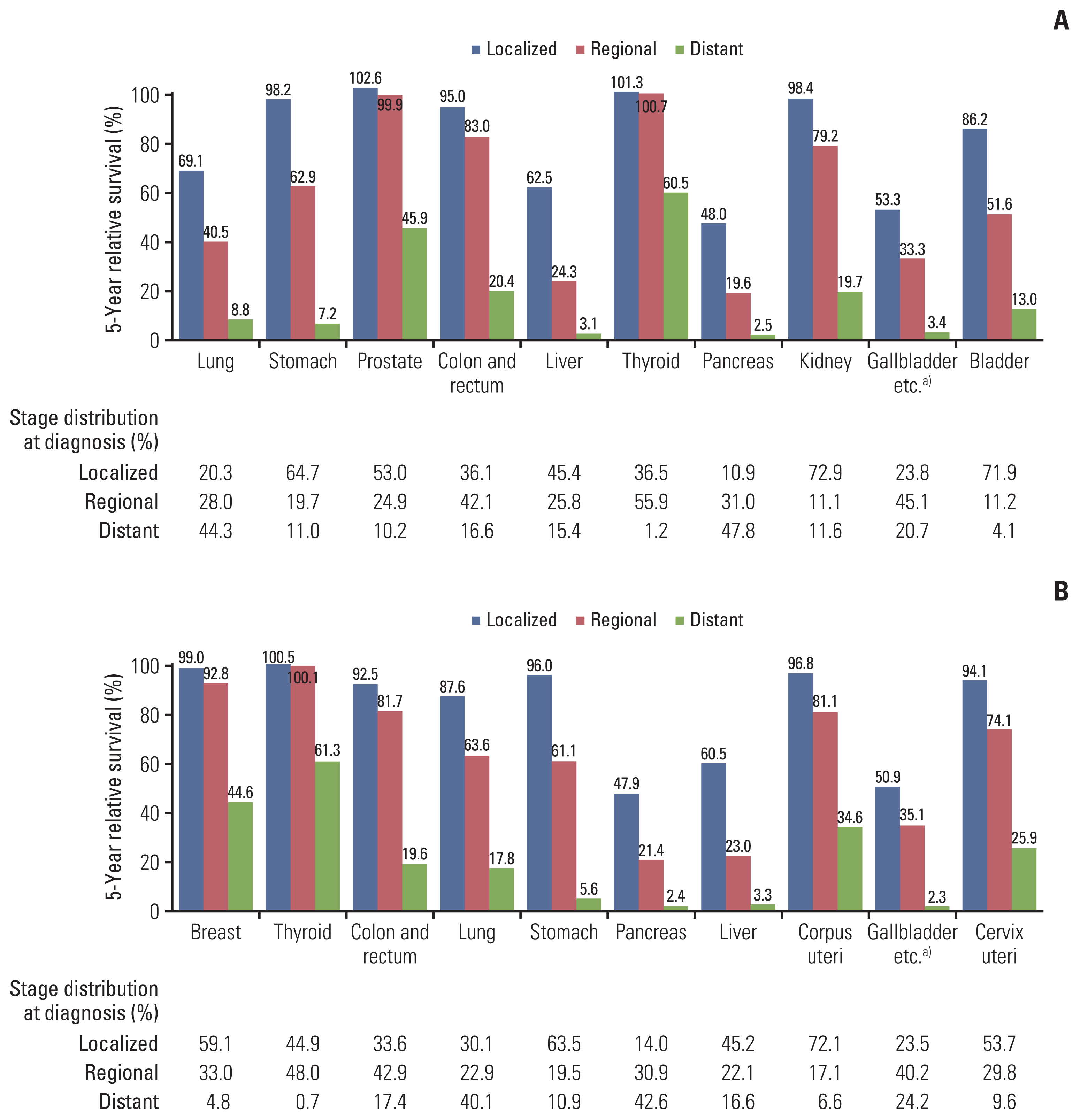
5. Prevalence rates
Table 7
| Site/Type | Crude prevalence rate per 100,000a) | Age-standardized prevalence rate per 100,000b) | ||||
|---|---|---|---|---|---|---|
|
|
|
|||||
| Both sexes | Men | Women | Both sexes | Men | Women | |
| All sites | 4,433.9 | 3,901.2 | 4,963.8 | 2,373.6 | 2,121.4 | 2,708.5 |
|
|
||||||
| Lip, oral cavity, and pharynx | 61.2 | 81.8 | 40.8 | 33.4 | 45.8 | 22.3 |
|
|
||||||
| Esophagus | 24.7 | 44.0 | 5.5 | 11.4 | 22.1 | 2.4 |
|
|
||||||
| Stomach | 643.1 | 850.9 | 436.4 | 304.5 | 436.8 | 194.1 |
|
|
||||||
| Colon and rectum | 569.8 | 676.7 | 463.4 | 267.5 | 350.3 | 199.5 |
|
|
||||||
| Liver | 151.8 | 227.4 | 76.6 | 77.2 | 122.3 | 36.0 |
|
|
||||||
| Gallbladderc) | 52.0 | 53.8 | 50.2 | 22.9 | 27.0 | 19.7 |
|
|
||||||
| Pancreas | 32.0 | 32.4 | 31.6 | 16.3 | 17.4 | 15.6 |
|
|
||||||
| Larynx | 23.9 | 45.0 | 2.8 | 10.9 | 22.6 | 1.2 |
|
|
||||||
| Lung | 216.6 | 258.7 | 174.7 | 101.5 | 131.0 | 78.8 |
|
|
||||||
| Breast | 545.2 | 4.0 | 1,083.6 | 307.6 | 2.1 | 606.2 |
|
|
||||||
| Cervix uteri | 117.8 | - | 234.9 | 65.2 | - | 128.0 |
|
|
||||||
| Corpus uteri | 65.8 | - | 131.2 | 37.1 | - | 73.2 |
|
|
||||||
| Ovary | 50.0 | - | 99.8 | 30.8 | - | 61.4 |
|
|
||||||
| Prostate | 234.5 | 470.3 | - | 96.5 | 223.9 | - |
|
|
||||||
| Testis | 8.5 | 17.1 | - | 7.6 | 14.8 | - |
|
|
||||||
| Kidney | 106.4 | 144.4 | 68.6 | 57.9 | 82.0 | 35.8 |
|
|
||||||
| Bladder | 81.5 | 133.1 | 30.1 | 35.7 | 66.5 | 11.6 |
|
|
||||||
| Brain and CNS | 26.1 | 26.9 | 25.3 | 21.2 | 22.5 | 19.9 |
|
|
||||||
| Thyroid | 953.6 | 357.5 | 1,546.6 | 587.8 | 226.8 | 947.2 |
|
|
||||||
| Hodgkin lymphoma | 7.1 | 8.8 | 5.4 | 5.7 | 6.8 | 4.6 |
|
|
||||||
| Non-Hodgkin lymphoma | 79.6 | 90.5 | 68.7 | 50.5 | 60.4 | 41.1 |
|
|
||||||
| Multiple myeloma | 16.2 | 17.1 | 15.3 | 7.9 | 9.0 | 7.0 |
|
|
||||||
| Leukemia | 52.9 | 58.8 | 47.0 | 46.0 | 51.4 | 40.6 |
|
|
||||||
| Other and ill-defined | 313.7 | 302.0 | 325.3 | 170.4 | 180.1 | 162.4 |
a) Crude prevalence rate: number of prevalent cases divided by the corresponding person-years of observation. Prevalent cases were defined as patients who were diagnosed between January 1, 1999 and December 31, 2020 and who were alive on January 1, 2021. Multiple primary cancer cases were counted multiple times,




 PDF
PDF Citation
Citation Print
Print



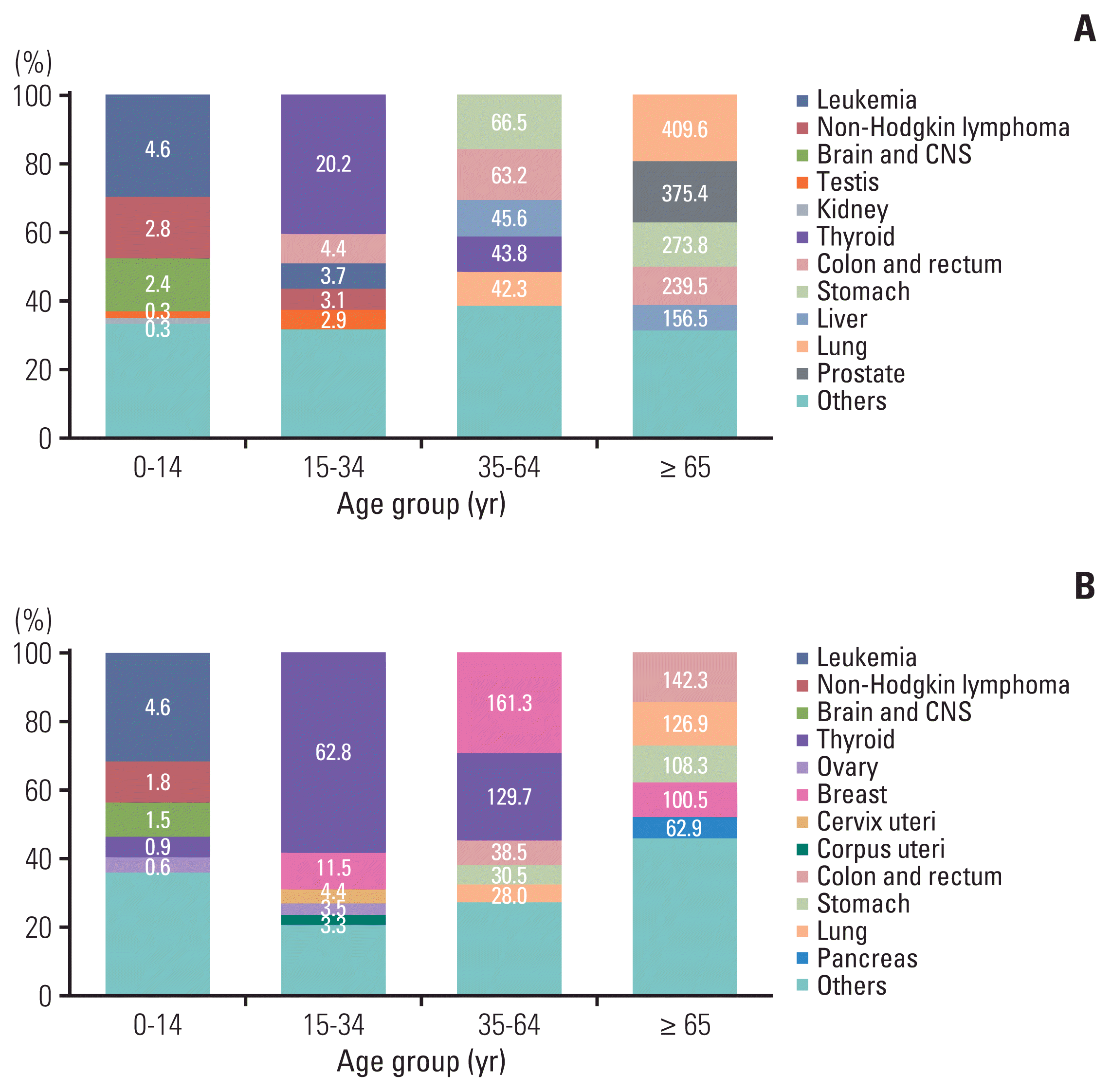
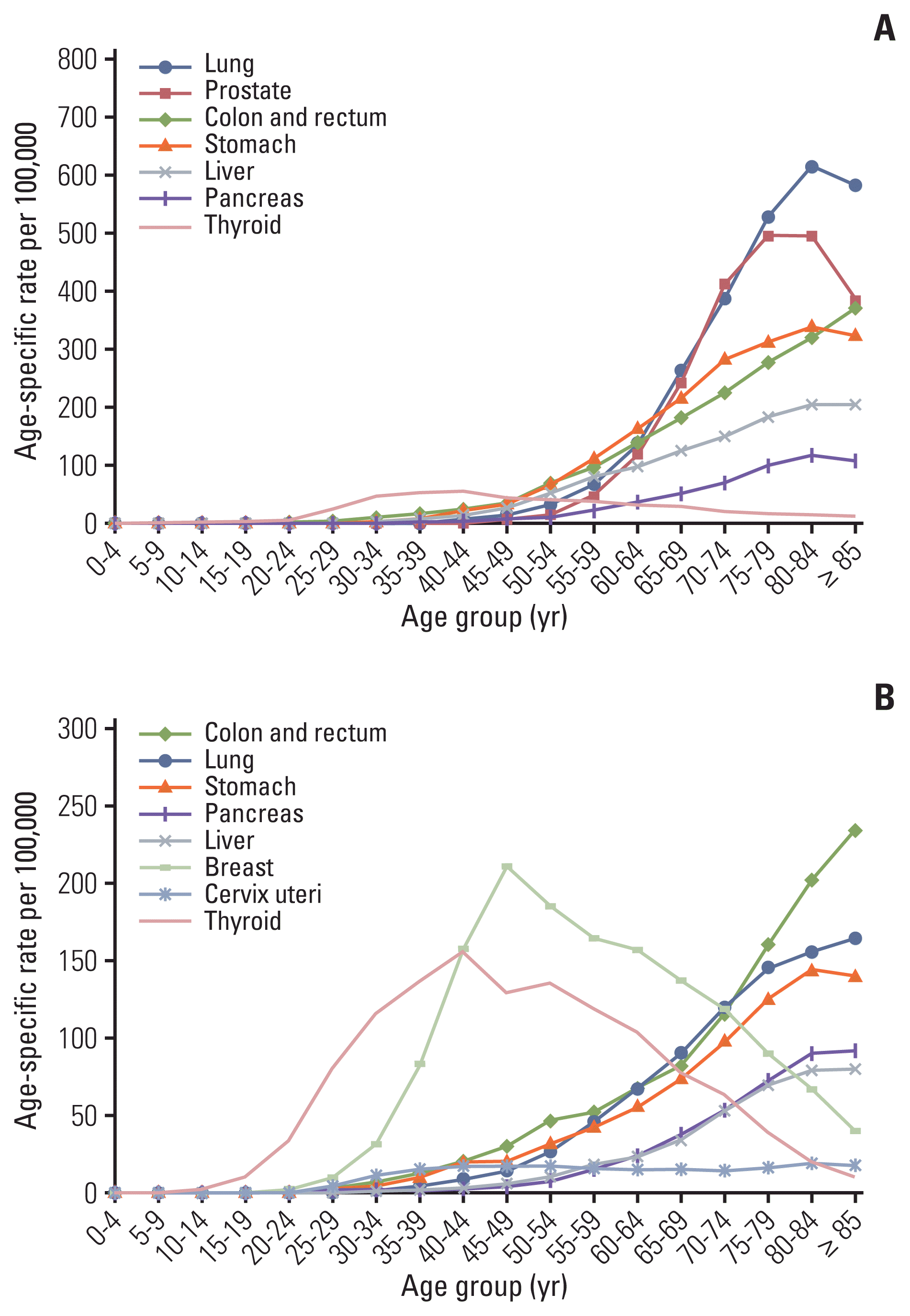
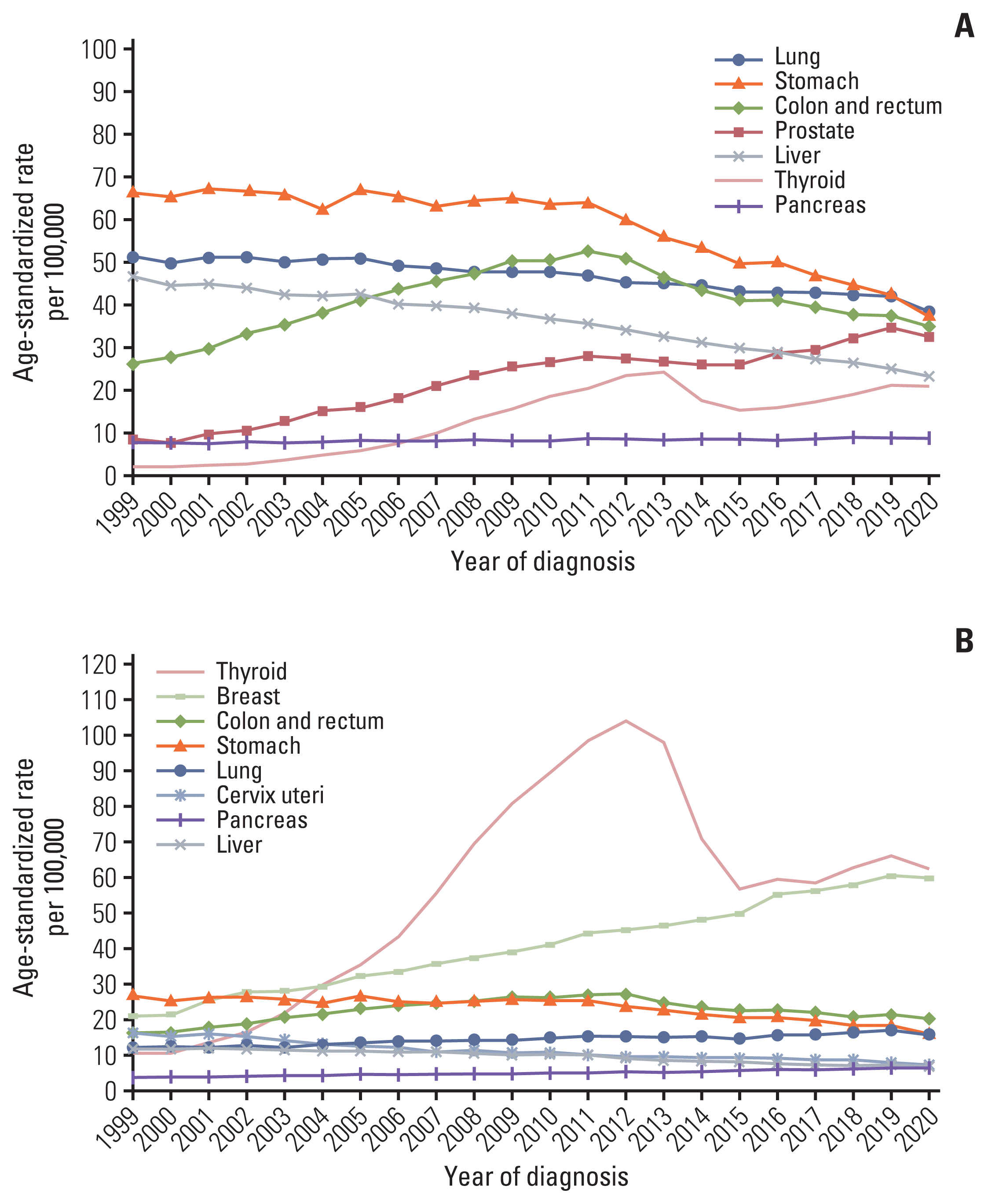
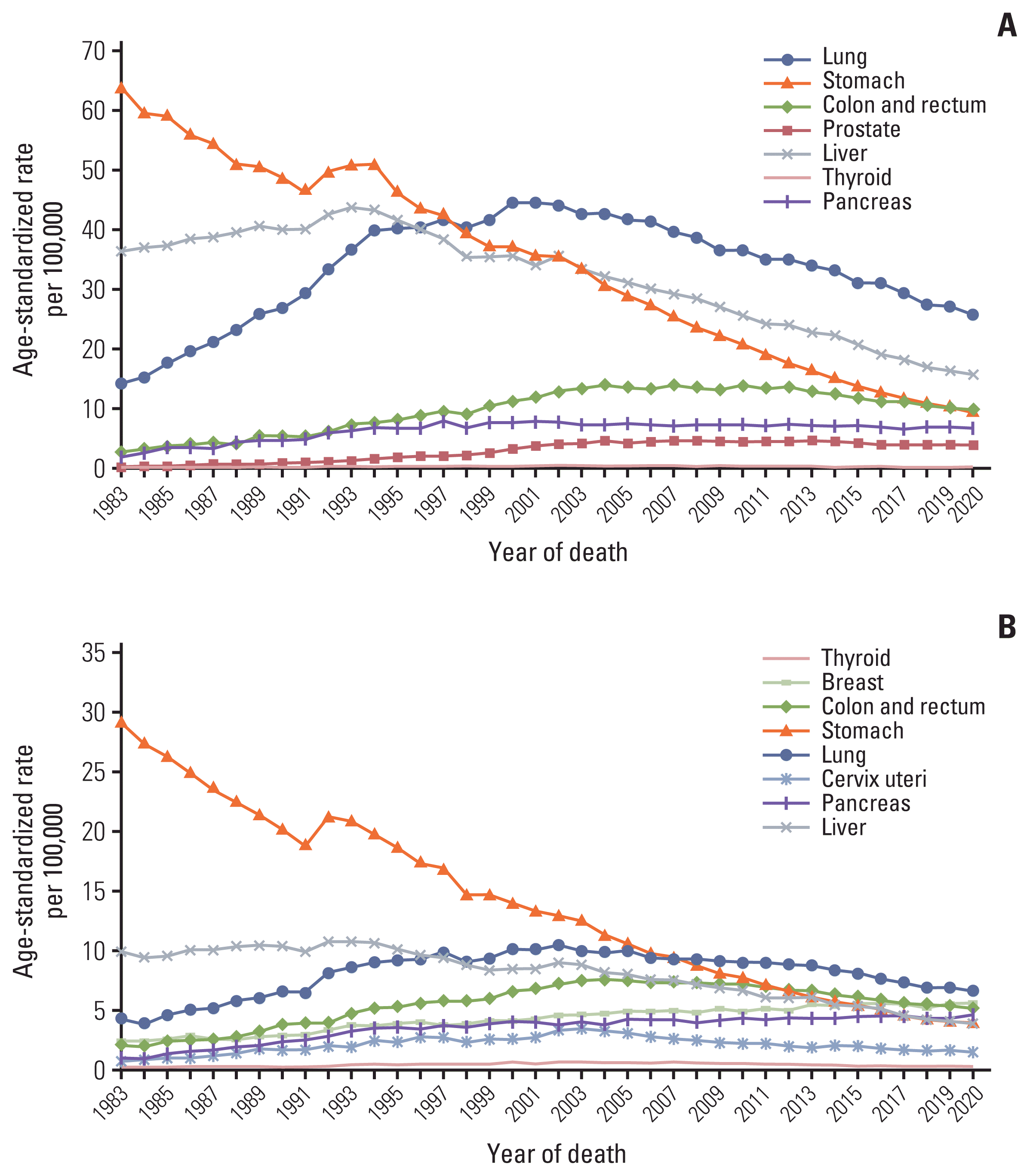
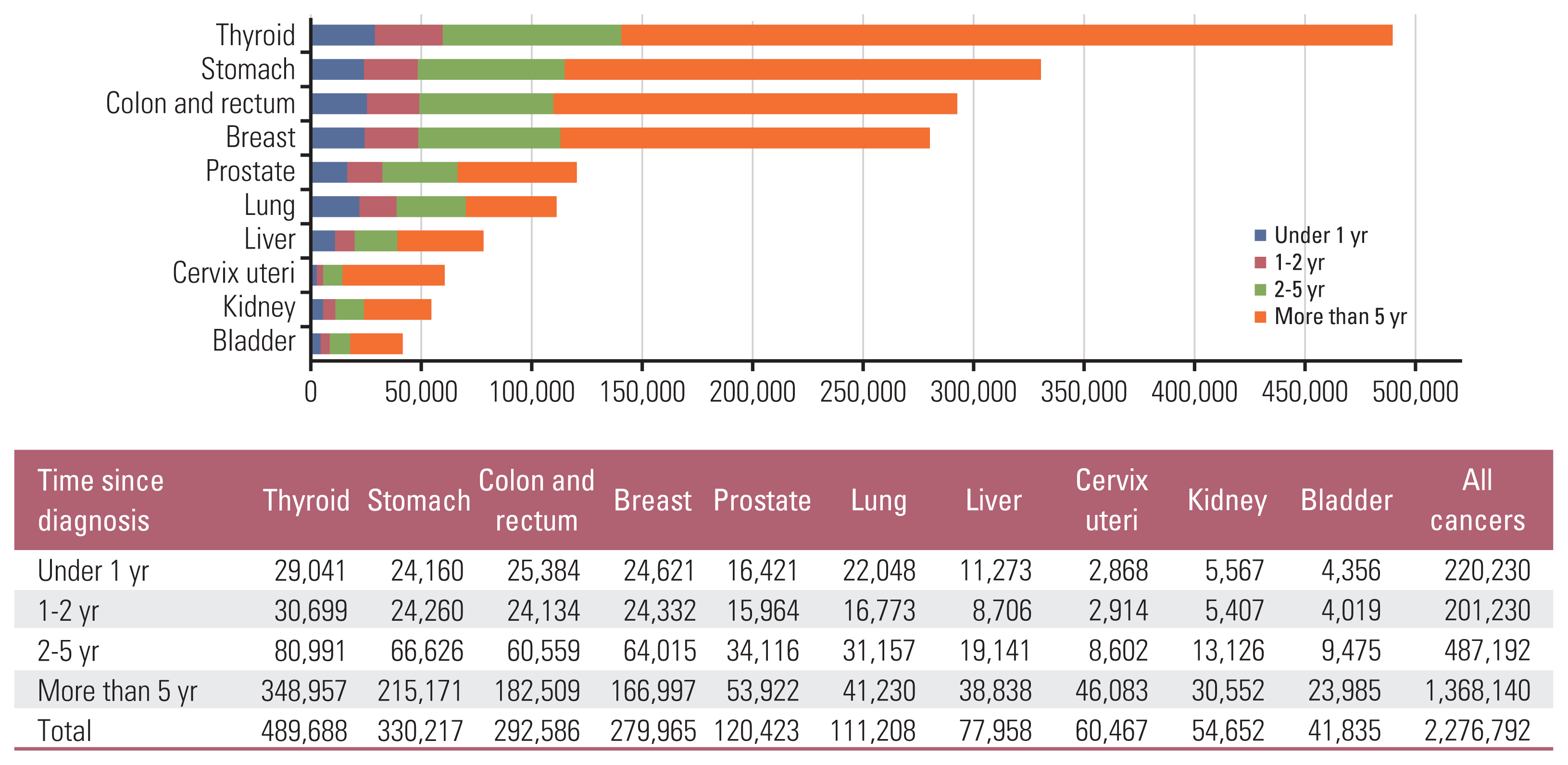
 XML Download
XML Download